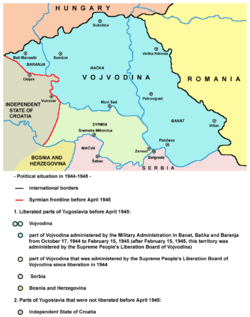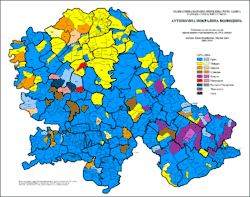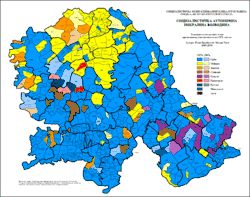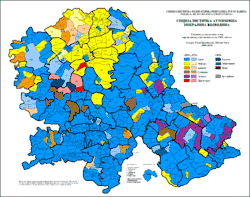Socialist Autonomous Province of Vojvodina
The Socialist Autonomous Province of Vojvodina (Serbian: Социјалистичка Аутономна Покрајина Војводина, romanized: Socijalistička Autonomna Pokrajina Vojvodina) was one of two political entities formed in Yugoslavia after World War II and one of the two autonomous provinces of Serbia within the Yugoslavia (the other being the Kosovo), between 1945 and the breakup of Yugoslavia. Until 1963, the province was named Autonomous Province of Vojvodina (Аутономна Покрајина Војводина / Autonomna Pokrajina Vojvodina), and had a lower level of autonomy.
| Socialist Autonomous Province of Vojvodina | |||||||||||||
|---|---|---|---|---|---|---|---|---|---|---|---|---|---|
| Autonomous province of Serbia in Yugoslavia | |||||||||||||
| 1944–1990 | |||||||||||||
 Vojvodina (dark red) in Serbia (red),and Republic of Kosovo (within the marked area) within Yugoslavia | |||||||||||||
| Capital | Novi Sad | ||||||||||||
| Area | |||||||||||||
• 1991 | 21,506 km2 (8,304 sq mi) | ||||||||||||
| Population | |||||||||||||
• 1991 | 1,952,533 | ||||||||||||
| Government | |||||||||||||
| • Type | Autonomous province | ||||||||||||
| President | |||||||||||||
| Historical era | Cold War | ||||||||||||
• Established | 1944 | ||||||||||||
• Disestablished | 1990 | ||||||||||||
| |||||||||||||
1944–1963


The Autonomous Province of Vojvodina (Serbian: Аутономна Покрајина Војводина / Autonomna Pokrajina Vojvodina) was formed in 1944. It was an autonomous province of Serbia, within the larger Federal People's Republic of Yugoslavia from 1945 to 1963, when it was transformed into the Socialist Autonomous Province of Vojvodina.
History
The province was formed in October 1944 when Soviet Red Army and Yugoslav partisans expelled Axis troops from the region. In this time, the final political status of the province was not yet determined and the newly formed provincial administration functioned independently from Serbia. The temporary borders of Vojvodina included the regions of Banat, Bačka and Baranja and most of the region of Syrmia with Zemun. The de jure temporary border between Vojvodina and Croatia in Syrmia was Vukovar-Vinkovci-Županja line. De facto, western parts of Syrmia remained under Axis military control until April 1945. From 17 October 1944 to 27 January 1945, most of the province (Banat, Bačka and Baranja regions) was under military administration.
In 30–31 July 1945, the provincial assembly of Vojvodina decided that the province should join Serbia. This decision was confirmed in the third AVNOJ assembly on 10 August 1945, and the law that regulated the autonomous status of Vojvodina within Serbia was adopted on 1 September 1945. The final borders of Vojvodina with Croatia and Central Serbia were defined in 1945: Baranja and western Syrmia were assigned to Croatia, while small parts of Banat and Syrmia near Belgrade were assigned to Central Serbia. A small part of northern Mačva near Sremska Mitrovica was assigned to Vojvodina. The capital city of the province was Novi Sad, which was also the capital of the former Danube Banovina province that existed before World War II.
Since 1945, Vojvodina enjoyed a limited level of autonomy within Serbia. In 1963, the name of the province was changed to the Socialist Autonomous Province of Vojvodina. Under the 1974 Yugoslav Constitution, the province gained extensive rights of self-rule, which defined Vojvodina as one of the subjects of the Yugoslav federation, and also gave it voting rights equivalent to Serbia itself on the country's collective presidency.
Demographics
- 1948 census
| Ethnicity | Number | % |
| Serbs | 841,246 | 50.6 |
| Hungarians | 428,932 | 25.8 |
| Croats | 134,232 | 8.1 |
| Slovaks | 72,032 | 4.3 |
| Romanians | 59,263 | 3.6 |
| Germans | 31,821 | 1.9 |
| Montenegrins | 30,589 | 1.9 |
| Rusyns and Ukrainians | 22,083 | 1.3 |
| Macedonians | 9,090 | 0.5 |
| Romani | 7,585 | 0.4 |
| Slovenes | 7,223 | 0.4 |
| Russians | 5,148 | 0.3 |
| Czechs | 3,976 | 0.3 |
| Bulgarians | 3,501 | 0.2 |
| Yugoslavs | 1,050 | 0.1 |
| Others | 5,441 | 0.3 |
- 1953 census
| Ethnicity | Number | % |
| Serbs | 865,538 | 50.9 |
| Hungarians | 435,179 | 25.6 |
| Croats | 127,027 | 7.5 |
| Slovaks | 71,153 | 4.2 |
| Romanians | 57,218 | 3.4 |
| Montenegrins | 30,516 | 1.8 |
| Rusyns | 23,038 | 1.4 |
| Macedonians | 11,622 | 0.7 |
| Others | 78,254 | 4.6 |
- 1961 census
| Ethnicity | Number | % |
| Serbs | 1,017,713 | 54.9 |
| Hungarians | 442,560 | 23.9 |
| Croats | 145,341 | 7.8 |
| Slovaks | 73,830 | 4 |
| Romanians | 57,259 | 3.1 |
| Montenegrins | 34,782 | 1.9 |
| Rusyns | 23,038 | 1.4 |
| Macedonians | 11,622 | 0.7 |
| Others | 83,480 | 4.4 |
1963–1990


The Socialist Autonomous Province of Vojvodina (Serbian: Социјалистичка Аутономна Покрајина Војводина / Socijalistička Autonomna Pokrajina Vojvodina) was one of the two socialist autonomous provinces of the Socialist Republic of Serbia from 1963 to 1990 and one of the federal units of the Socialist Federal Republic of Yugoslavia from 1974 to 1990. Its capital was Novi Sad.
History
The Autonomous Province of Vojvodina that was created in 1944 enjoyed only the small level of autonomy within Serbia since 1945. In 1963, the name of the province was changed to Socialist Autonomous Province of Vojvodina. Under the 1974 Yugoslav Constitution, the province gained extensive rights of self-rule, which defined Vojvodina as one of the subjects of the Yugoslav federation, and also gave it voting rights equivalent to Serbia itself on the country's collective presidency.
Under the rule of the Serbian president Slobodan Milošević, Vojvodina and Kosovo lost most of their autonomy on 28 September 1990. After this, the Vojvodina was no longer a subject of the Yugoslav federation, but again only the autonomous province of Serbia, with limited level of autonomy. The name of the province was also reverted to Autonomous Province of Vojvodina.
Demographics
According to the 1981 census, the population of the province included:
- Serbs = 1,107,375 (54.4%)
- Hungarians = 385,356 (18.9%)
- Croats = 119,157 (5.9%)
- Slovaks = 69,549 (3.4%)
- Romanians = 47,289 (2.3%)
- Montenegrins = 43,304 (2.1%)
- Rusyns and Ukrainians = 24,306 (1.2%)
- Others = 238,436 (11.8%)
Politics
The only authorised political party in the province was the League of Communists of Vojvodina (Savez komunista Vojvodine), which was part of the League of Communists of Serbia (Savez komunista Srbije) and part of the League of Communists of Yugoslavia (Savez komunista Jugoslavije).
The Constitution of the Socialist Autonomous Province of Vojvodina (Ustav Socijalističke Autonomne Pokrajine Vojvodine) was the higher juridical act of the province.
Institutions
Institutions of the Socialist Autonomous Province of Vojvodina included:
- Presidency (Predsedništvo)
- Working bodies of presidency (Radna tela predsedništva):
- Council for people's defence (Savet za narodnu odbranu)
- Council for protection of constitutional system (Savet za zaštitu ustavnog poretka)
- Commission for organizational and staff questions (Komisija za organizaciona i kadrovska pitanja)
- Commission for amnesty (Komisija za pomilovanja)
- Commission for applications and suggestions (Komisija za predstavke i predloge)
- Commission for medals (Komisija za odlikovanja)
- Commission for economic reform (Komisija za privrednu reformu)
- Parliament (Skupština)
- Councils of parliament (Veća skupštine):
- Council of associated work (Veće udruženog rada)
- Council of municipalities (Veće opština)
- Social-political council (Društveno-političko veće)
- Provincial committees (Pokrajinski komiteti):
- Provincial committee for energetics and raws (Pokrajinski komitet za energetiku i sirovine)
- Provincial committee for international cooperation (Pokrajinski komitet za međunarodnu saradnju)
- Provincial committee for traffic and connections (Pokrajinski komitet za saobraćaj i veze)
- Provincial committee for water economy (Pokrajinski komitet za vodoprivredu)
- Provincial committee for education and culture (Pokrajinski komitet za obrazovanje i kulturu)
- Provincial committee for work (Pokrajinski komitet za rad)
- Provincial committee for health and social protection (Pokrajinski komitet za zdravlje i socijalnu zaštitu)
- Provincial committee for veteran and invalid questions (Pokrajinski komitet za boračka i invalidska pitanja)
- Provincial committee for urbanism, residential questions and protection of human environment (Pokrajinski komitet za urbanizam, stambena pitanja i zaštitu čovekove sredine)
- Provincial committee for informations (Pokrajinski komitet za informacije)
- Provincial committee for social planning (Pokrajinski komitet za društveno planiranje)
- Provincial committee for legislation (Pokrajinski komitet za zakonodavstvo)
- Provincial committee for science and informatics (Pokrajinski komitet za nauku i informatiku)
- Provincial social councils (Pokrajinski društveni saveti):
- Provincial social council for questions of social regulation (Pokrajinski društveni savet za pitanja društvenog uređenja)
- Provincial social council for economic development and economic politics (Pokrajinski društveni savet za privredni razvoj i ekonomsku politiku)
- Provincial social council for foreign relations (Pokrajinski društveni savet za odnose sa inostranstvom)
- Government (Izvršno veće)
- Provincial bodies of administration (Pokrajinski organi uprave):
- Provincial secretarity for people's defence (Pokrajinski sekretarijat za narodnu odbranu)
- Provincial secretarity for internal affairs (Pokrajinski sekretarijat za unutrašnje poslove)
- Provincial secretarity for jurisdiction and administration (Pokrajinski sekretarijat za pravosuđe i upravu)
- Provincial secretarity for finances (Pokrajinski sekretarijat za finansije)
- Provincial secretarity for industry, construction, and terciar activities (Pokrajinski sekretarijat za industriju, građevinarstvo i tercijarne delatnosti)
- Provincial secretarity for agriculture, food industry and wood industry (Pokrajinski sekretarijat za poljoprivredu, prehrambenu industriju i šumarstvo)
- Provincial secretarity for market, prices, monitoring of economic developments and tourism (Pokrajinski sekretarijat za tržište, cene, praćenje privrednih kretanja i turizam)
- Provincial administrative organizations (Pokrajinske upravne organizacije):
- Provincial establishment for social planning (Pokrajinski zavod za društveno planiranje)
- Provincial establishment for statistics (Pokrajinski zavod za statistiku)
- Provincial establishment for public administration (Pokrajinski zavod za javnu upravu)
- Provincial establishment for international scientific, cultural, educational and technical cooperation (Pokrajinski zavod za međunarodnu naučnu, kulturnu, prosvetnu i tehničku saradnju)
- Provincial establishment for hydro-meteorogy (Pokrajinski hidrometeorološki zavod)
- Provincial establishment for staff affairs (Pokrajinski zavod za kadrovske poslove)
- Provincial establishment for prices and monitoring of economic developments (Pokrajinski zavod za cene i praćenje privrednih kretanja)
- Provincial administration for geodetic and property-juridical affairs (Pokrajinska uprava za geodetske i imovinsko-pravne poslove)
- Administration for budget (Uprava za budžet)
- Provincial administration for social profit (Pokrajinska uprava društvenih prihoda)
- Provincial directorate for stock reserves (Pokrajinska direkcija za robne rezerve)
- Services for general and joint affairs of provincial institutions (Službe za opšte i zajedničke poslove pokrajinskih organa)
- Jurisdictional institutions of SAP Vojvodina (Pravosudni organi SAP Vojvodine):
- Constitutional court of Vojvodina (Ustavni sud Vojvodine)
- Supreme court of Vojvodina (Vrhovni sud Vojvodine)
- Public prosecution of SAP Vojvodina (Javno tužilaštvo SAP Vojvodine)
- Public juristical defence of SAP Vojvodina (Javno pravobranilaštvo SAP Vojvodine)
- Provincial social juristial defender of autonomy (Pokrajinski društveni pravobranilac samoupravljanja)
- Court of associated work (Sud udruženog rada)
Presidents
Presidents of presidency of the Socialist Autonomous Province of Vojvodina:
- Radovan Vlajković (1974–1981)
- Predrag Vladisavljević (1981–1982)
- Danilo Kekić (1982–1983)
- Đorđe Radosavljević (1983–1984)
- Nandor Major (1984–1985)
- Predrag Vladisavljević (1985–1986)
- Đorđe Radosavljević (1986–1988)
- Nandor Major (1988–1989)
- Jugoslav Kostić (1989–1991)
See also
Part of a series on the |
|---|
| History of Vojvodina |
  |
|
|
|
|
|
- Vojvodina
- History of Vojvodina
- Socialist Federal Republic of Yugoslavia
- Socialist Republic of Serbia
- Socialist Autonomous Province of Kosovo
- 1944–1945 killings in Vojvodina
Sources
- Dragomir Jankov, Vojvodina – propadanje jednog regiona, Novi Sad, 2004.
- Dimitrije Boarov, Politička istorija Vojvodine, Novi Sad, 2001.
- Stefan Grubač, Srbija – severno krilo, Novi Sad, 1990.
- Autonomija Vojvodine – izabrani spisi, Politička teorija i praksa – knjiga 4, Centar PK SKV za političke studije i marksističko obrazovanje, Novi Sad, 1976.
External links
